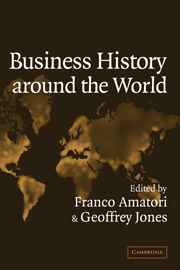Book contents
- Frontmatter
- Contents
- Acknowledgments
- List of Contributors
- Business History around the World
- 1 Introduction
- PART I GENERAL ISSUES, OPEN QUESTIONS, CONTROVERSIES
- PART II AREA PATTERNS
- PART III COMPARATIVE BUSINESS HISTORY
- 16 Family Firms in Comparative Perspective
- 17 Multinationals
- 18 Business-Government Relations: Beyond Performance Issues
- 19 The Opportunities for Business History at the Beginning of the Twenty-First Century
- Index
- References
17 - Multinationals
Published online by Cambridge University Press: 24 July 2009
- Frontmatter
- Contents
- Acknowledgments
- List of Contributors
- Business History around the World
- 1 Introduction
- PART I GENERAL ISSUES, OPEN QUESTIONS, CONTROVERSIES
- PART II AREA PATTERNS
- PART III COMPARATIVE BUSINESS HISTORY
- 16 Family Firms in Comparative Perspective
- 17 Multinationals
- 18 Business-Government Relations: Beyond Performance Issues
- 19 The Opportunities for Business History at the Beginning of the Twenty-First Century
- Index
- References
Summary
The study of the business history of multinationals has generated an extensive literature that, although drawn on and inspired by Chandlerian concepts, has also developed a strong identity of its own. The literature has at least three distinctive features. First, there has been an attempt to develop comparative frameworks and to explore issues using cross-national comparisons. Second, there has been considerable interaction between business historians and economic theorists of the multinational. Third, business history research has made an impact on, and is cited in, the wider literature on contemporary multinationals written by economists and international business theorists.
PIONEERS
In one sense, the literature on the history of multinationals has a long ancestry. Foreign direct investment (FDI) — along with portfolio investment — forms one component of foreign investment as a whole, and the extensive historical literature on nineteenth-century capital flows contains valuable insights on international business. However these studies, and later ones by economic historians, focused on capital flows and did not make the distinction between portfolio flows of capital and FDI, which involves ownership as well as control. It was in the United States that the earliest studies of FDI and multinationals began. These studies predated the invention of the term “multinational” around 1960. During the interwar years, a number of U.S. academics published FDI estimates and analyses of the growth and impact of multinational enterprises. These included discussions of the management and technological as well as financial aspects of these firms.
- Type
- Chapter
- Information
- Business History around the World , pp. 353 - 371Publisher: Cambridge University PressPrint publication year: 2003
References
- 9
- Cited by

